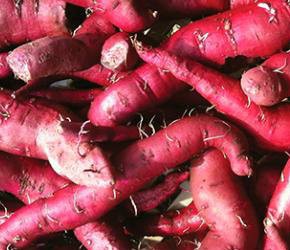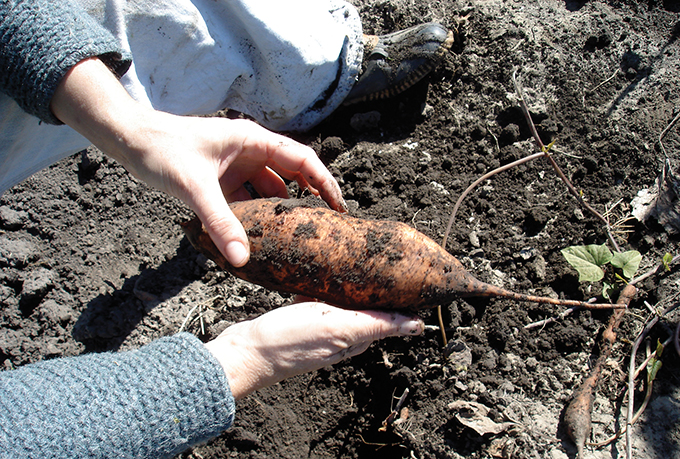Sweet harvest: Notes from the farm

As soon as the nights dip into the 30s and frost threatens, my brother Henry drops everything and calls all hands to come help dig up the sweet potatoes.
As I leave my house to answer the call, I watch a hairy woodpecker work away at the already large holes he’s made in the dead oak off the north side of the house. They are two or three inches in diameter—big enough so that he can perch on the rim and tip his whole body up and over the edge and into the hole to find some delicious grub. Mostly, though, he is patient, quiet, and still—waiting for the bug to make the first move, then levering himself in for the kill.
When I pick up the binoculars he seems to glance over his shoulder at me—one large eye fearlessly piercing my two assisted ones. Then he turns back to his waiting, and I to my watching. He is harvesting too, using these last warm days to stock up on food for winter—the same as we are—although he packs it on as body fat while we pack it in our freezers, cupboards, basements, and root cellars.
Read our latest issue or browse back issues.
As soon as I put down the binoculars, my attention shifts from the woodpecker to the impossibly deep blue sky all around him. E. E. Cummings must have been looking at just such a sky when he wrote of the “blue true dream of sky.” This week before the autumn equinox is the time when the air seems clearest, the sun brightest, and the sky bluest. In a few days, and for a brief moment, day and night will be evenly balanced. Then the rapid slide to the winter solstice begins, with each day getting shorter and each night longer.
But right now we’re at the glorious cusp of the seasons, and as I enter Henry’s vegetable fields they display their own equinox, balancing equal parts summer crops (waning) and autumn crops (waxing). This week the moon will be waxing too, leading up to the full harvest moon. For the farmer, the harvest moon is less a dreamy notion and more a simple fact: the full moon nearest the autumn equinox. It rises early in the evening, eliminating any dark interval between sunset and moonrise, which meant in years past that harvesting could continue by moonlight. Although it may seem romantic to work by moonlight, it is easier and more practical to work in the barn under electric lights both before dawn, usually cleaning and braiding garlic, and after sunset, washing vegetables.
During the hours when our spinning planet faces the sun, there are cover crops to sow, dry beans and dry corn to harvest and process, dozens and dozens of 50-pound crates of roots (beets, carrots, turnips, daikon, burdock, parsnips, salsify, potatoes, winter radishes) to dig up and wash, and winter squash and pumpkins to pick out of the field and load on hayracks.
But today all of that work is put on hold as we enter the sweet potato patch armed with digging forks, bushel baskets, and wooden crates. The wildly vining plants entirely cover the rich soil, some leaves green, others reddish-purple, others brown. We work in pairs. One person uses the fork to unearth the potatoes, while the other person follows along on hands and knees to grab the sweet potatoes and put them in a basket or crate.
We work with urgency because thousands of pounds of sweet potatoes must get out of the ground before the soil temperature falls below 50. The sooner the sweet potatoes are dug and cured, the better their flavor will be, and the longer they will keep. Sweet potatoes are warm-season plants native to the tropics, and so are very sensitive to cold temperatures. The greatest danger from delayed digging is the risk of cold, wet soil that will lead the tubers to swiftly decay. What staves off that decay and promotes the development of flavor is getting the potatoes out of the ground promptly and then curing them.
A cure is a means of preservation. Meats are often cured with smoke or a mixture of salt, sugar, and nitrate. We air-cure the garlic by hanging it from the barn rafters all summer and into the fall. We sun-cure the winter squash and pumpkins by putting them out on hayracks in the autumn sunshine. And we heat-cure the sweet potatoes.
This means that as soon as the sweet potatoes are dug, before they are even washed, Henry takes over a room in the farm interns’ trailer, spreads tarps all over the floor, and puts the sweet potatoes out in a single layer on trays propped up off the floor to allow air to circulate underneath them. He then creates tropical conditions by bringing in a small electric space heater and draping soaked towels and sheets on clotheslines suspended from the ceiling and walls to increase the humidity. Sweet potatoes cure best at around 90 degrees and 90 percent humidity. These conditions cause the periderm, the skin and the layer underneath it, to thicken and re-form, healing any bruises or cuts and triggering the development of enzymes that convert some of the starch in the roots to sugar. So for the next week or two, it is a farm intern’s job to monitor the temperature and humidity closely, rewetting the towels and sheets twice or even three times daily, keeping the sweet potatoes in their sauna, so that we and our customers will be able to enjoy them all winter long.
The interns don’t mind having the sweet potatoes take over some of their territory because the curing room is a great place to return to after a cold, rainy October day. It is also a nice place to warm up in before going out on a frosty morning. And the sweet, earthy aroma emanating from the room warms the soul and promotes sweet dreams.
Sweet potatoes are indeed sweet, but they are neither potatoes nor yams, being rather a member of the Convolvulus or morning glory family. The confusion began when Europeans first encountered sweet potatoes in Haiti in 1492. The fleshy tuber was known by various names, but the one that stuck was the Haitian one, batata. Later this name was inadvertently applied to the ordinary potato—another New World crop. Meanwhile, at about the same time but on the other side of the world, Portuguese slave traders, watching Africans digging up a large root, asked what it was. The Africans replied to what seemed an inane question by stating the obvious, that it was “something to eat”—nyami in a language of Guinea. So yam became an alternate term for sweet potato in British and Portuguese colonies. True yams, however, are very large, starchy roots of the Dioscorea genus. To confuse matters further, when soft, orange-fleshed sweet potatoes were introduced in the United States in the mid-20th century, producers and shippers wanted to distinguish them from the lighter colored, drier varieties. To do so, they used the word yam. But “yams” in the U.S. are actually just sweet potatoes with moist texture and orange flesh.
 |
Henry grows many varieties of sweet potatoes, including the classic orange, moist “yam” varieties such as the Beauregard, Jewell, and Georgia Jet. He also grows Japanese, Korean, and Okinawa sweet potatoes. Except for the Okinawan sweet potato, which is bright purple-blue inside and out, the Asian sweet potatoes generally have a purplish skin and a yellow or cream-colored flesh that is much drier, sweeter, and more flavorful than the “yam” varieties.
After curing for 10–14 days, the sweet potatoes will last up to six months if they are stored between 55 and 60 degrees, with good airflow. Any temperature lower than that (your refrigerator, for example) will lead to the same problems caused by the cool autumn soil, namely, rot. On the other hand, sweet potatoes improve with age when stored at the proper temperature, since the maltose sugar–creating enzymes continue to work. Some years we’ve had perfect sweet potatoes clear into May—bringing us full circle, when the new sweet potato slips in the hoop house are ready to be transplanted into the field for the next season’s sweet potatoes.
But spring is far from where we are now, kneeling, balanced on the cusp of the seasons, extracting sweet potatoes from the deep black earth under the blue true dream of sky.






